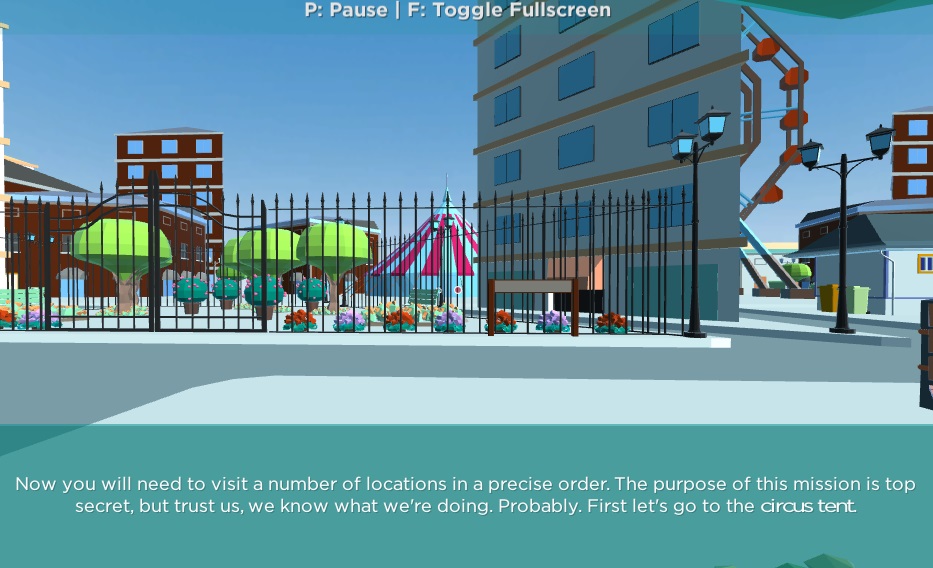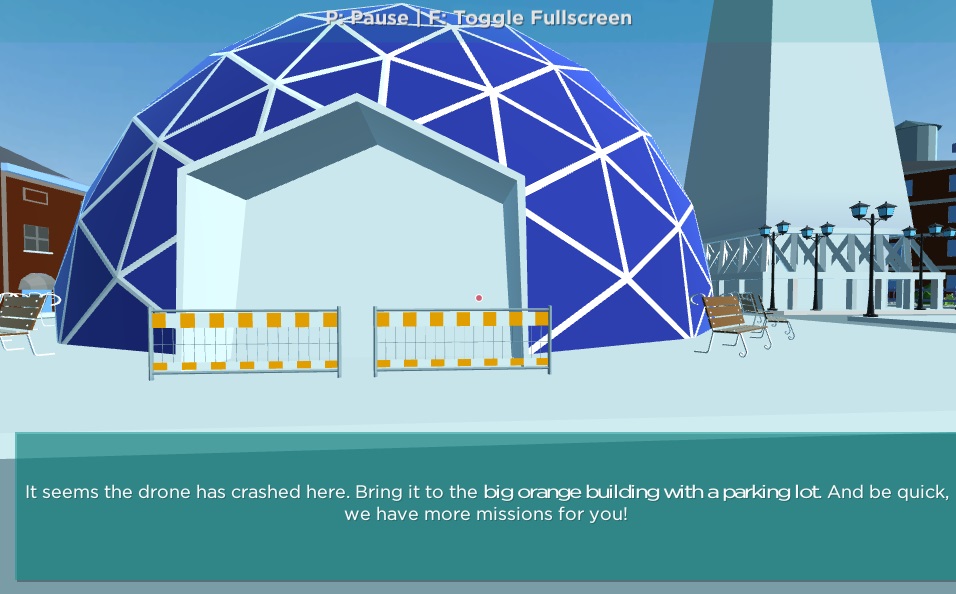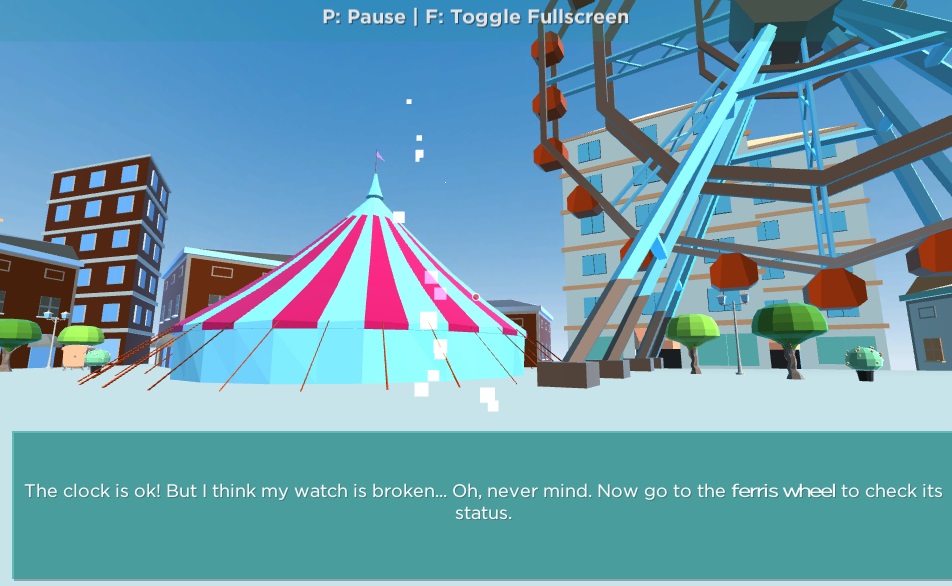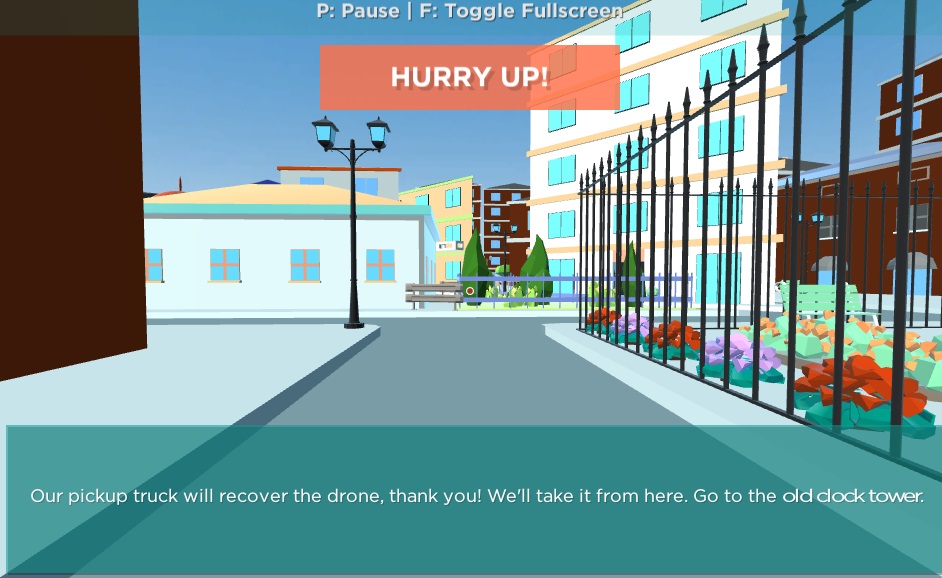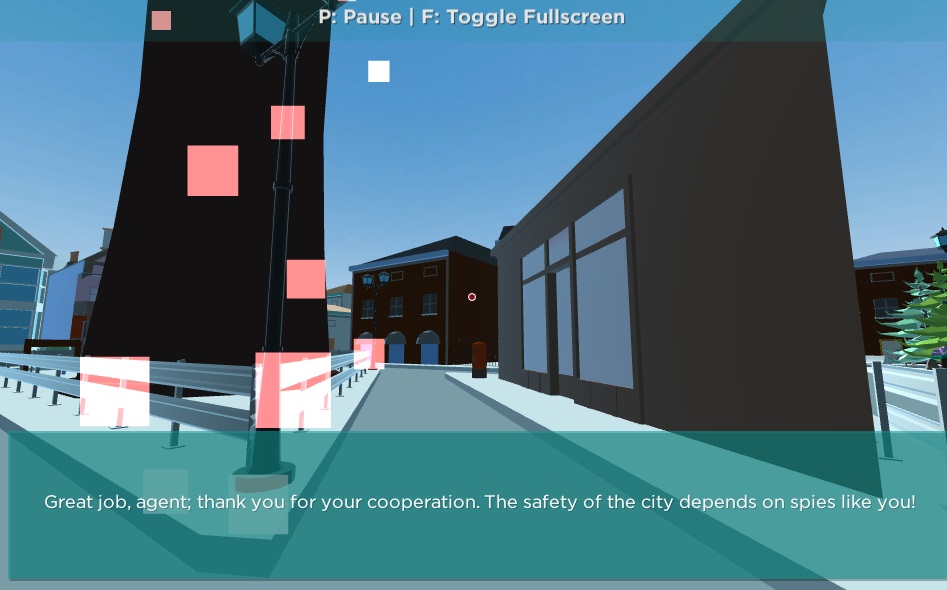Description
Example images from Orientation Landmark missions are shown below. A written description of a mission now follows.
There were 5 Orientation Landmark tests ('missions') in the Navigation battery. Each mission had the same rules and followed the same pattern of activity. Missions were further subdivided into a number of similar tasks: there were 5 tasks in every Orientation Direction mission except for mission 1, which had 4 tasks. Twins were only allowed one attempt to succeed in responding correctly in each task.
Each task involved following an instruction to reach a target adjacent to a named landmark within the virtual world of the game (depicted as a town with streets and landmarks). The instruction for each new task was provided on screen in the form of text such as 'now go to the cathedral'. The tasks in each mission followed a predetermined sequence; the end-point for one task was also the starting point for the next task. The chosen landmarks were depicted as tall structures that were visible from a distance within the virtual world, although not necessarily visible from every point; hence, if not immediately visible, they would become visible if a twin persisted in moving around the streets. In some tasks of later missions, memory of the location of landmarks within the virtual world might help twins to locate the targets more quickly. The target (shown on screen as a group of sparkling dots) was always adjacent to the named landmark, which often meant that, having reached the landmark, a twin had to move around it in order to locate the target.
Each Orientation Landmark task had a time limit of 60 seconds for completion. The maximum time that could be spent on the mission was therefore the sum of the task time limits (240 seconds for mission 1, 300 seconds for missions 2, 3, 4 and 5). There was no progress bar or timer on screen to help twins keep track of time; however, "hurry up" prompts appeared on screen as the time limit approached in each task. If the time limit expired without the target being reached, then the task would simply end and the next task would begin.
Feedback was provided at each stage in order to keep a twin moving towards the goal of completing the mission. There were normally only two possible outcomes for each task: either it was completed successfully (target reached) or it was failed (by timing out). As mentioned above, an approaching timeout was signalled by 'hurry up' messages flashing on the screen; and ultimate failure was implied by the task ending without success. Successful completion of the task was explicitly shown in more than one way: as the target was approached, it appeared on screen in the form of a group of sparkling dots; and when the target was reached, success was signalled using text on screen.
In order to respond in this type of mission, movement in the virtual world was achieved by holding down the mouse button to move forwards, and by moving the mouse to left or right in order to turn. If a twin did not make any input during the 60 second time limit of a task (no mouse-down events), then the task would time out without any meaningful response data being recorded. If an entire mission (comprising 4 or 5 tasks) passed without any input at all, then the game would be 'auto-paused' after the final task, to prevent a sequence of missions from proceeding unattended and without input. After auto-pausing, a message would appear on screen, requiring the twin to click on a button in order to proceed to the next mission in the battery.
In Orientation Landmark missions, neither the compass nor the map appeared on screen.
As in all other Navigation missions, twins could pause at any stage by pressing P on the keyboard; this would stop the clock and blank out the image of the streets. A further click on P would then resume the mission.
Because of the nature of Orientation Landmark missions, it is not possible to reproduce the items (tasks) in any detail. However, the text instructions for each task in each mission are given below in the Table of Test Items, and example images from missions are shown under the next heading.
Example Images
The images below are screen shots taken from Orientation Landmark missions. These images serve as examples of how tasks were carried out and missions completed. Each task involved an instruction (provided on screen as text) to go to a specific landmark and there to find the target.
The first image, below), is taken from the very start of an Orientation Landmark mission. This is one of the earlier missions (mission 2), and the instruction text provides a reminder of the overall aim: 'visit a number of locations in a precise order'. The instruction names the landmark which is the target for task 1 of this mission ('First let's go to the circus tent'). Note that in this case the landmark (circus tent) is clearly visible from the starting point, but in tasks of later missions this was not always the case. Note also that neither compass nor map appear on screen in Orientation Landmark missions.
The second image, below, is taken just after the end of one task and at the start of another task in a mission. The text on screen gives feedback to indicate success in the task just completed ('it seems the drone has crashed here'), and provides the instruction for the new task ('Bring it to the big orange building with a parking lot'). The text also reminds the twin that this is one of several tasks in the mission ('we have more missions for you'). Note that the next landmark (the orange building) is not visible in this view, but would become visible if the twin rotated the view by moving the mouse to right or left.
The next image (below) illustrates the sparkling dots that show the position of the target as it is approached; in this image, the target has not yet quite been reached. The text at the bottom of the screen has not changed since the start of the task - it still shows the feedback from the previous task ('The clock is ok') and the instruction for the current task ('Now go to the ferris wheel'). The ferris wheel, which is the landmark for this task, can be seen on the right side of this image.
The next image (below) illustrates the 'hurry up' prompt that flashed repeatedly on the screen as the 60-second task time limit approached. If a task timed out before it could be completed, then the next task would start without further feedback. Note that the text at the bottom of the screen remains the same from start to end of each task.
The final image (below) illustrates the feedback given after successful completion of the last task and hence of the mission. The text at the bottom of the screen, which varied from mission to mission, indicates successful completion ('Great job') and implies that the mission has ended ('thank you for your cooperation'). Note that the text does not include an instruction for a further task, again suggesting that the mission has ended. This text stayed on screen for a few seconds and then the next mission would begin. In earlier tasks of the mission, the sparkling dots disappeared as soon as the target was reached; but in the final task, as shown here, the sparkling dots remained visible while the final mission feedback was given.
Web Test Rules
All five Orientation Landmark missions followed these rules:
- Tasks
Each mission comprised either 4 or 5 tasks. All tasks in a mission were compulsory and were presented in a fixed order. - Attempts
Only one attempt was allowed to complete each task. Each task ended either on successful completion or with failure due to a timeout. - Timeout rule
A time limit of 60 seconds applied to each task. As the time limit approached, text warnings would appear on screen ('hurry up') but there was no other indication of the passing of time. When the task timed out, it would simply end and the next task would start. - Widgets
Neither the compass nor the map appeared on screen for any tasks. - Pausing
The mission could be paused at any time by pressing P on the keyboard. The image of the virtual world was then replaced on screen by text explaining that the mission was paused, and that pressing P again would resume. Each mission could be paused indefinitely in this way, as often as a twin wished. - Auto-pausing
If a twin left a mission unattended for the entire duration of all the tasks, no input would be recorded and it would eventually time out. In these circumstances, in order to prevent a sequence of missions from timing out without input, an "auto-pause" would come into effect: the entire game was paused at the end of the mission, and the image of the virtual world on screen was replaced by explanatory text. A twin could then resume (at the start of the next mission) by clicking on a button. An Orientation Landmarks mission left unattended in this way was effectively forfeited, and was not presented again. - Task outcomes
The possible outcomes for each task were as follows:- Success: target reached
- Failure due to timeout
- Timeout with no input in the task (could occur in each task independently or across all tasks in the entire mission)
Dataset Item Variables
The raw item variables relating to each Orientation Landmarks mission, as listed in the table below, were generated automatically by programs on the web server. For the sake of completeness, the table also lists derived variables relating directly to an Orientation Landmarks mission or its component tasks. Note that the dataset only includes data for completed missions. If a twin started a mission but left it unfinished, then the data for that mission were deleted from the dataset.
Note that the raw outcome variables for each task (rcnolXtYcm1/2, rcnolXtYer1/2) have been dropped from the dataset in favour of a single more informative outcome variable (rcnolXtYr1/2). The start and end dates/times have not been retained in the dataset.
In all variable names, X denotes the mission number (1 to 5) and Y denotes the task number (1 to 5).
| Variables | Explanation | Values |
|---|---|---|
| rcnolXdata1/2 | Mission data flag: are mission data present? [DERIVED VARIABLE] | 0=no, 1=yes |
| rcnolXstat1/2 | Mission status: was the mission completed? [DERIVED VARIABLE] | 0=not started, 1=started but not finished, 2=finished successfully, 3=compromised by loss of data |
| rcnolXsttm1/2 | Start date and time of the mission [not in dataset] | Date-time values |
| rcnolXentm1/2 | End date and time of the mission [not in dataset] | Date-time values |
| rcnolXtime1/2 | Time interval from start to end of the mission [DERIVED VARIABLE] | Minutes (decimal values) |
| rcnolXdurn1/2 | Duration of actual activity during the mission | 0-240 or 0-300 seconds (decimal values) |
| rcnolXtYcm1/2 | Was task Y completed successfully? [DROPPED FROM DATASET] | 1=yes, 0=no |
| rcnolXtYer1/2 | Was an error made in task Y? [DROPPED FROM DATASET] | 1=yes, 0=no |
| rcnolXtYrt1/2 | Reaction time, from start of task to start of twin input, in task Y | Seconds (decimal values) |
| rcnolXtYct1/2 | Completion time, from start to end of task Y (whether completed or failed) | Seconds (decimal values) |
| rcnolXtYr1/2 | Coded outcome of task Y [DERIVED VARIABLE] | 1=completed successfully, -1=failed due to timeout, -4=no input during the task |
| rcnolXtYas1/2 | Accuracy score for task Y [DERIVED VARIABLE] | 0-1 (decimal values) |
| rcnolXas1/2 | Mission accuracy score [DERIVED VARIABLE] | 0-1 (decimal values) |
| rcnolXss1/2 | Mission speed score [DERIVED VARIABLE] | 0-1 (decimal values) |
| rcnolXts1/2 | Mission total score [DERIVED VARIABLE] | 0-1 (decimal values) |
Table of Test Items
The table below gives the text instructions for each task in each Orientation Landmark mission, and the feedback text given after successful completion of the final task. Within the instruction text for each task, the landmark target is highlighted with bold type.
| Mission | Task | Text instruction (landmark target in bold font) |
|---|---|---|
| 1 | 1 | The briefcase contained instructions to check the security of several buildings around the city. Reach the road between the black and white pyramid and the tall building with balconies. |
| 2 | Ok! Now walk to the obelisk (tall grey column) in front of the cathedral. | |
| 3 | Everything is fine! Now reach the tall white pyramid skyscraper. | |
| 4 | All good! Now go to the ferris wheel. We need to know if the amusement park is working properly... | |
| feedback | It appears that the ferris wheel has been sabotaged by someone. We will send a technical team there right away. Good job! | |
| 2 | 1 | Now you will need to visit a number of locations in a precise order. The purpose of this mission is top secret, but trust us, we know what we're doing. Probably. First let's go to the circus tent. |
| 2 | In the lion cage you have found a vial containing an unknown substance. Take it to the water tower in front of the stadium. | |
| 3 | We have analysed the sample: it contained lion's DNA. Puzzling. Now reach the tall dark chimney. | |
| 4 | There is a drone flying back and forth from here to the blue round glass skyscraper. Go there, let's investigate. | |
| 5 | The drone seems to by flying around with no real purpose. We will keep a close eye on it. Now reach the cathedral. | |
| feedback | The bishop confirmed no suspect activity around here, glad to know that! Let's move on. | |
| 3 | 1 | We need updated intelligence for some of the buildings you previously checked for security. Reach the blue round glass skyscraper to observe the activity of the drone you saw flying there. Check all round the building! |
| 2 | It seems the drone has crashed here. Bring it to the big orange building with a parking lot. And be quick, we have more missions for you! | |
| 3 | Our pickup truck will recover the drone, thank you! We'll take it from here. Go to the old clock tower. | |
| 4 | The clock is ok! But I think my watch is broken... Oh, never mind. Now go to the ferris wheel to check its status. | |
| 5 | It seems the sabotage has been repaired. Now go to the tall dark chimney and let's finish this mission. | |
| feedback | Great job, agent; thank you for your cooperation. The safety of the city depends on spies like you! | |
| 4 | 1 | The message instructs you to go to the park near the old clock tower. We have information about a problem there. |
| 2 | There was a problem; a false passport hidden in a flower vase! The cheek of it. Now go to the cupcake shop in front of the obelisk (tall grey column). Be quick! | |
| 3 | You have now a box of cupcakes with you. Bring it to the four colourful houses in front of the tall dark chimney. | |
| 4 | Thank you for bringing me a cupcake! Not an appropriate job for a spy, you say? Well, you don't know what was hidden inside... Now reach the road between the white pyramid skyscraper and the small fenced garden. | |
| 5 | Ah! You have found my cat! It has a microfilm capsule hidden in its collar. Now reach the small black and white pyramid near the round blue skyscraper. | |
| feedback | Ok, we have recovered the microfilm. It contains an itemised list of top secret new spy gadgets of incalculable value. To the next mission! | |
| 5 | 1 | You should know this city quite well by now. A film festival will begin tomorrow, so let's check if the tourist attractions are safe. Reach the cathedral. |
| 2 | What a beautiful building! Now go to the circus tent - we have to make sure the amusement park is ready for opening. Hurry up! | |
| 3 | The ringmaster of the circus gave you two tickets for the show! If you hurry and finish your missions, maybe we can attend together. But first reach the bright green structure with a news stand near the water tower. | |
| 4 | Now check the area around the big blue dome, next to the tall white pyramid skyscraper. | |
| 5 | The astronomical observatory is closed, they need more time but they will be ready by tomorrow. Now reach the parking lot in front of an orange building. | |
| feedback | Thank you for bringing us the hotel guestbook! We will run a check for known aliases. |
